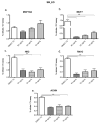Exploring the Bioactive Potential and Chemical Profile of Schinus molle Essential Oil: An Integrated In Silico and In Vitro Evaluation
- PMID: 40805798
- PMCID: PMC12349550
- DOI: 10.3390/plants14152449
Exploring the Bioactive Potential and Chemical Profile of Schinus molle Essential Oil: An Integrated In Silico and In Vitro Evaluation
Abstract
Chilean Schinus molle has been used in traditional medicine for effects such as antibacterial, antifungal, anti-inflammatory, analgesic, antiviral, antitumoral, antioxidant, antispasmodic, astringent, antipyretic, cicatrizant, cytotoxic, diuretic, among others. In this study, we evaluated the pharmacological potential of Schinus molle seed essential oil extract (SM_EO) through in vitro and in silico approaches. In vitro, the antioxidant potential was analyzed, and antitumor activity was evaluated in non-tumor and human epithelial tumor cell lines. Caenorhabditis elegans was used as a model for evaluating toxicity, and the chemical composition of the SM_EO was analyzed using gas chromatography-mass spectrometry. The oil contained four major monoterpenes: α-phellandrene (34%), β-myrcene (23%), limonene (13%), and β-phellandrene (7%). Based on quantum mechanical calculations, the reactivity of the molecules present in the SM_EO was estimated. The results indicated that α- phellandrene, β-phellandrene, and β-myrcene showed the highest nucleophilic activity. In addition, the compounds following these as candidates for antioxidant and antiproliferative activities were α-phellandrene, β-phellandrene, ρ-cymene, sabinene, caryophyllene, l-limonene, and α-pinene, highlighting β-myrcene. Based on ADME-Tox properties, it is feasible to use these compounds as new drug candidates. Moreover, the antibacterial activity MIC value obtained for B. cereus was equivalent to 2 μg/mL, and for Y. enterocolitica, S. enteritidis, and S. typhimurium, the MIC value was 32.5 μg/μL. SM_EO could selectively inhibit the proliferation of human epithelial mammary tumor MCF7 cells treated with SM_EOs at 64 and 16 ug/mL-a significant increase in BCL-2 in a dose-dependent manner-and showed low toxicity against Caenorhabditis elegans (from 10 to 0.078 mg·mL-1). These findings suggest that SM_EO may be a potential source of bioactive compounds, encouraging further investigation for applications in veterinary medicine, cosmetics, and sanitation.
Keywords: Caenorhabditis elegans; Schinus molle; antimicrobial activity; antioxidant; antiproliferative; chemical composition; essential oil; toxicity.
Conflict of interest statement
The authors declare no conflicts of interest.
Figures








Similar articles
-
Prescription of Controlled Substances: Benefits and Risks.2025 Jul 6. In: StatPearls [Internet]. Treasure Island (FL): StatPearls Publishing; 2025 Jan–. 2025 Jul 6. In: StatPearls [Internet]. Treasure Island (FL): StatPearls Publishing; 2025 Jan–. PMID: 30726003 Free Books & Documents.
-
Tetraclinis articulata (Vahl) Mast. essential oil as a promising source of bioactive compounds with antimicrobial, antioxidant, anti-inflammatory and dermatoprotective properties: In vitro and in silico evidence.Heliyon. 2023 Dec 2;10(1):e23084. doi: 10.1016/j.heliyon.2023.e23084. eCollection 2024 Jan 15. Heliyon. 2023. Retraction in: Heliyon. 2025 Mar 26;11(9):e43085. doi: 10.1016/j.heliyon.2025.e43085. PMID: 38169772 Free PMC article. Retracted.
-
Essential Oil From Dittrichia viscosa L.: A Potential Source of Bioactive Substances With Antioxidant, Antimicrobial, and Antidiabetic Properties: In Vitro and In Silico Studies.Adv Pharmacol Pharm Sci. 2025 Aug 18;2025:9951847. doi: 10.1155/adpp/9951847. eCollection 2025. Adv Pharmacol Pharm Sci. 2025. PMID: 40860627 Free PMC article.
-
The Black Book of Psychotropic Dosing and Monitoring.Psychopharmacol Bull. 2024 Jul 8;54(3):8-59. Psychopharmacol Bull. 2024. PMID: 38993656 Free PMC article. Review.
-
Systemic pharmacological treatments for chronic plaque psoriasis: a network meta-analysis.Cochrane Database Syst Rev. 2021 Apr 19;4(4):CD011535. doi: 10.1002/14651858.CD011535.pub4. Cochrane Database Syst Rev. 2021. Update in: Cochrane Database Syst Rev. 2022 May 23;5:CD011535. doi: 10.1002/14651858.CD011535.pub5. PMID: 33871055 Free PMC article. Updated.
References
-
- Rossini C., Menéndez P., Dellacassa E., Moyna P. Essential Oils from Leaves of Schinus molle and S. lentiscifolius of Uruguayan Origin. J. Essent. Oil Res. 1996;8:71–73. doi: 10.1080/10412905.1996.9700558. - DOI
-
- Kasimala MB K.B. A review on Brazilian pepper plant: Schinus molle. J. At. Mol. 2012;2:6–13.
-
- Madaleno I.M., Delatorre-Herrera J. Medicina popular de Iquique, Tarapacá. Idesia. 2013;31:67–78. doi: 10.4067/S0718-34292013000100009. - DOI
-
- Marongiu B., Porcedda A.P.S., Casu R., Pierucci P. Chemical composition of the oil and supercritical CO2 extract of Schinus molle L. Flavour. Fragr. J. 2004;19:554–558. doi: 10.1002/ffj.1350. - DOI
-
- MINSAL. 2012. [(accessed on 17 July 2025)]. Available online: https://ispch.gob.cl/andim/repositorio-publicaciones-isp/repositorio-pub....
LinkOut - more resources
Full Text Sources

